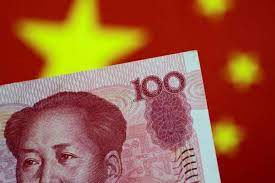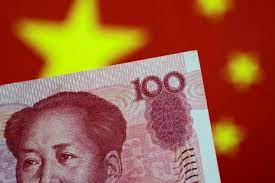
China's lending benchmark credit prime rate (LPR) was slashed for the very first time in 20 months on Monday, in an effort to boost development in the stagnating economy. However, the economy's highly leveraged housing industry remains a concern.
The one-year LPR was cut by 5 basis points to 3.80 per cent from 3.85 per cent whereas the five-year LPR stayed at 4.65 per cent.
This is the first time the LPR has been reduced since April 2020.
Reuters polled 39 traders and analysts last week, and 29 of them projected LPR cutbacks.
The one-year LPR is used for the majority of new and outstanding loans in China, whereas the five-year rate determines residential mortgage pricing.
"The cut reinforces our view that authorities are increasingly open to cutting interest rates amid looming economic headwinds," said Xing Zhaopeng, senior China strategist at ANZ.
He did say, though, that Beijing's move to maintain the five-year rate exhibited that it wanted "not to use the property sector to stimulate economic growth."
According to Goldman Sachs estimates, the Chinese central bank's two reserve requirement ratio (RRR) reduction earlier this year have helped organizations to slash their borrowing costs, with the twin cuts saving banks up to 28 billion yuan ($4.39 billion).
While China's decision to cut the LPR was widely anticipated, it emphasises the country's monetary policy divergence from other major central banks, which are likely to hike interest rates.
Some economists believe Beijing would soften further to arrest the economic decline, but they are split on the pace of easing.
A plethora of latest economic measures, including retail sales and investment growth, hint to a weakening Chinese economy, while investor morale has been affected by regulatory restrictions on the IT sector. New restrictions to combat the soaring number of COVID-19 cases could put even more pressure on the economy.
"We expect a further 45 bp of cuts to the one-year LPR during 2022," Mark Williams, chief Asia economist at Capital Economics, said in a note.
According to ANZ's Xing, another RRR drop is expected in early 2022 due to rising credit concerns in the property industry.
According to Yan Se, chief economist at Founder Securities, China's central bank dropped interest rates by a lesser percentage than its global peers during the peak of the pandemic last year, allowing it to ease further now.
In the first quarter of 2022, he expects Beijing to cut interest rates on the central bank's medium-term lending facility (MLF) by 10 basis points, followed by more LPR cuts.
In 2022, however, Li Wei, a senior economist at Standard Chartered for China, does not expect any broad-based RRR or policy rate decreases.
"We maintain our call for no change in the seven-day reverse repo rate and the one-year MLF rate in 2022, as major central banks are expected to tighten monetary policy and China's CPI should trend higher on PPI passthrough and rising pork inflation," Li said.
(Source:www.business-standard.com)
The one-year LPR was cut by 5 basis points to 3.80 per cent from 3.85 per cent whereas the five-year LPR stayed at 4.65 per cent.
This is the first time the LPR has been reduced since April 2020.
Reuters polled 39 traders and analysts last week, and 29 of them projected LPR cutbacks.
The one-year LPR is used for the majority of new and outstanding loans in China, whereas the five-year rate determines residential mortgage pricing.
"The cut reinforces our view that authorities are increasingly open to cutting interest rates amid looming economic headwinds," said Xing Zhaopeng, senior China strategist at ANZ.
He did say, though, that Beijing's move to maintain the five-year rate exhibited that it wanted "not to use the property sector to stimulate economic growth."
According to Goldman Sachs estimates, the Chinese central bank's two reserve requirement ratio (RRR) reduction earlier this year have helped organizations to slash their borrowing costs, with the twin cuts saving banks up to 28 billion yuan ($4.39 billion).
While China's decision to cut the LPR was widely anticipated, it emphasises the country's monetary policy divergence from other major central banks, which are likely to hike interest rates.
Some economists believe Beijing would soften further to arrest the economic decline, but they are split on the pace of easing.
A plethora of latest economic measures, including retail sales and investment growth, hint to a weakening Chinese economy, while investor morale has been affected by regulatory restrictions on the IT sector. New restrictions to combat the soaring number of COVID-19 cases could put even more pressure on the economy.
"We expect a further 45 bp of cuts to the one-year LPR during 2022," Mark Williams, chief Asia economist at Capital Economics, said in a note.
According to ANZ's Xing, another RRR drop is expected in early 2022 due to rising credit concerns in the property industry.
According to Yan Se, chief economist at Founder Securities, China's central bank dropped interest rates by a lesser percentage than its global peers during the peak of the pandemic last year, allowing it to ease further now.
In the first quarter of 2022, he expects Beijing to cut interest rates on the central bank's medium-term lending facility (MLF) by 10 basis points, followed by more LPR cuts.
In 2022, however, Li Wei, a senior economist at Standard Chartered for China, does not expect any broad-based RRR or policy rate decreases.
"We maintain our call for no change in the seven-day reverse repo rate and the one-year MLF rate in 2022, as major central banks are expected to tighten monetary policy and China's CPI should trend higher on PPI passthrough and rising pork inflation," Li said.
(Source:www.business-standard.com)





